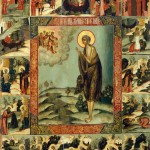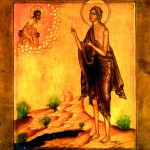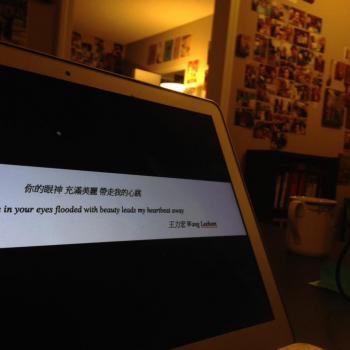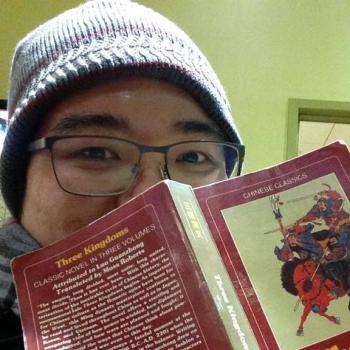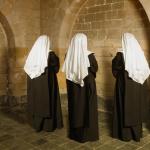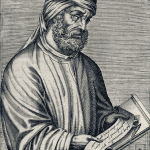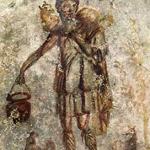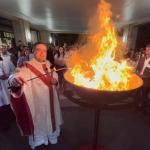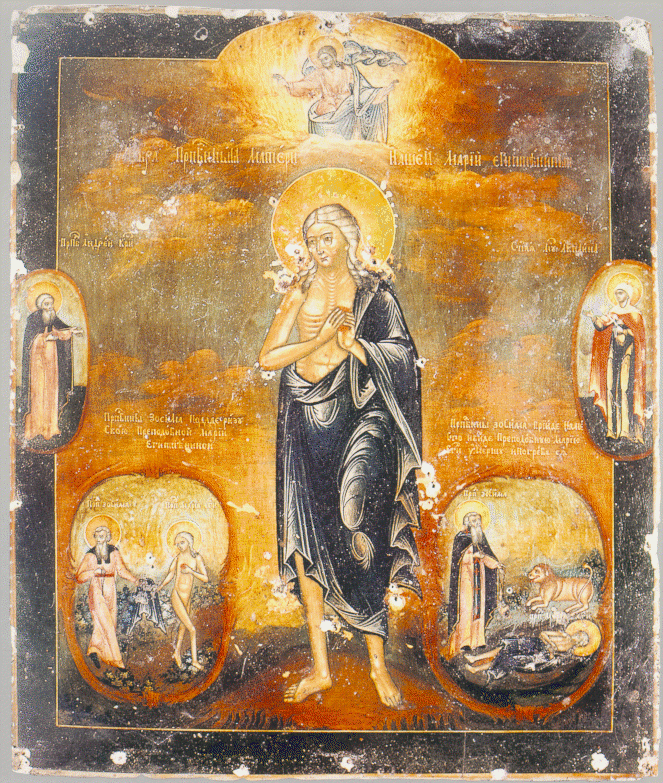
This is the third in a series of posts on the Great Canon of St Andrew of Crete, a penitential service in the Byzantine cycle for the Great Fast that quite literally changed my body to pray in a Byzantine way. The first post was about how I struggled to do prostrations because I was completely unprepared for the Great Canon, and the second was on my realization that the story of Abba Zosima in the Life of Holy Mary of Egypt is about the futility of the fantasy that one can find a perfect spiritual father. Perhaps it will also become clear through this series why I have a special love for the desert hermit, our Venerable Mother Mary of Egypt, in whose life the Most Holy Theotokos also plays a special role.
I have a dear, dear friend who has the admirable quality of persisting in his misunderstanding of the word eros despite my attempts, as well as those of many of our mutual friends, to correct him. In part, this is my fault. When he once complained for the bazillionth time that he could not find himself a girlfriend, I invited him to a lecture on eros, in which the very able lecturer Jason Lepojärvi exegeted Anders Nygren and C.S. Lewis on eros, with hints toward Wojtyła, to an interdisciplinary group of evangelical academics. My friend, of course, didn’t hear a word of the textual analysis; every time he heard the word eros, he uttered a very audible, almost orgasmic, and therefore rather disturbing sigh, so badly did he want what he thought was a ‘fulfilled sex drive’ described by all these great European philosophers. I was sitting next to my doctoral supervisor during this lecture, and he gave me a glance every so often to check if my friend was ok. Thereafter, all my friend thought about eros was that it was about sex, and no amount of Plato has seemed to be able to cure him.
The only comparable misunderstanding of eros of such magnitude can arguably be found in Rod Dreher’s Benedict Option, where Dreher insists that a turn toward eros in contemporary civilization is responsible for Western incoherence around sex. ‘Instead of teaching us what we must deprive ourselves of to be civilized,’ Dreher writes, ‘we have a culture built on the cult of desire, one that tells us we find meaning and purpose in releasing ourselves from the old prohibitions, as we self-directed individuals choose.’ Dreher goes on to blame this ‘cult of desire’ for the ‘Sexual Revolution,’ the ‘Me Decade’ of the 1970s, the concomitant mushrooming of the ‘divorce rate,’ the continuous affirmation of ‘abortion rights,’ and a straight line between ‘the advent of the birth control pill in the 1960s’ to the ‘newest vanguards of the Sexual Revolution, transgendered [sic] people’ (p. 43). Eros here just simply refers to people getting off because of something sexual that they did.
Bringing this back to my meditation on the Life of St Mary of Egypt in the Great Canon of St Andrew of Crete, I think this misunderstanding makes for a misreading of Holy Mary of Egypt that shortchanges what she might have to teach us about holiness and penitence. Certainly, the beginning of the part where Holy Mary of Egypt tells Abba Zosima about her life is about sex: she runs away from home when she was twelve, engages in all kinds of juicy sex acts that she can’t talk about for shame, refuses pay because she enjoyed it all so much, and then uses her body to book passage on a boat headed toward Jerusalem for the Exaltation of the Holy Cross so that she can seduce even more people in Palestine. I can see why Frederica Matthewes-Green calls her a ‘sexual athlete’ (Facing East, p. 54).
But slow the pace of the story down with the prostrations of the Great Canon, and each word is heard, each phrase is savoured, and like my spiritual father says, after he did the Great Canon a few times, he felt that he needed to hear the Life of St Mary of Egypt like a child – every single word has to be read in the exact same order every time, or else it just feels wrong.
Even though I am very much a neophyte when it comes to the Great Canon, I think I understand what he’s talking about. He read to us the first half of the Life, and I came to a realization about what spiritual fathers were and were not. The second half, though, was read by a woman around my age who can be described as the epitome of the EvangeliCatholic of the Audrey Assad/Matt Maher ilk; indeed, instead of attracting rad trad Latins like some other Eastern Catholic temples, our temple in Vancouver seems to specialize in Asian Canadian evangelicals and EvangeliCatholics. Imagine Audrey Assad singing Galician chant; that is often what our temple sounds like, and it is with a voice like that that I first encountered the second half of the Life of St Mary of Egypt, and I still can’t hear it any other way when I read the text myself.
If there’s one thing that evangelicals and EvangeliCatholics like to talk about, it also tends to be eros as sex too. I was raised evangelical and have been told that I’m pretty much an Eastern EvangeliCatholic in my tendencies toward informality, and I’ve even embraced it all recently by writing about the whole Mike Pence dining rules tempest-in-a-teapot and the evangelical sexual obsessions that come with it. Knowing that Holy Mary of Egypt was supposed to have been a ‘sexual athlete’ who converted and hearing the story set up in an evangelical/EvangeliCatholic voice certainly heightened the expectation that this would be like the standard youth group narrative of ‘I used to be addicted to porn, but I got an accountability group after I was really touched by this amazing experience of worship, so now I don’t feel tempted anymore, praise Jesus.’
But this is the beginning of Holy Mary of Egypt’s story; it is not its end. Holy Mary of Egypt is turned back by an invisible force at the doors of the Church of the Holy Sepulchre; everybody pushes their way in, but she is pushed back. Three times this happen, and then she beholds the icon of the Theotokos on the wall. Jean-Luc Marion makes the profound point that what makes an icon an icon and not an ‘idol’ is that one never really looks at an icon; it is the icon who looks at you, which means of course the icon has agency to interact with Mary of Egypt – if it didn’t, it wouldn’t be an icon. Holy Mary of Egypt acknowledges the icon’s address to her as a sinner and she is permitted within the sanctuary to venerate the Cross on which the Lord’s body was nailed; she comes out to thank the icon, and the icon instructs her to go out into the desert in repentance, to go beyond the Jordan into exile. Along the way, a stranger gives her three loaves of bread, and she partakes of the holy mysteries at the Church of St John the Baptist. Then she crosses the Jordan, and it is forty-seven years until Abba Zosima happens upon her.
When I heard this part of the story, it dawned on me that this is an illustration of what eros is really about. The philosophers Sam Rocha and Adi Burton point out that one of the central organizing themes in Pope Emeritus Benedict XVI’s theology is what the retired Bishop of Rome calls in his 2007 Lenten speech ‘the mad eros of the cross,’ the crazed desire of the Creator of the universe to possess the creation that he now lacks because of its sin and ‘yearns for union with the beloved.’ ‘One could rightly say,’ Benedict continues, ‘that the revelation of God’s eros toward man is, in reality, the supreme expression of his agape. In all truth, only the love that unites the free gift of oneself with the impassioned desire for reciprocity instils a joy which eases the heaviest of burdens.’ Rocha and Burton show that in this way, ‘Benedict’s argument…renders a route to the eros that unifies the variations of love that arrives in the strength of death’s embrace, an embrace strong enough to break the shackles of time itself’ (p. 7). As Rocha points out in his recent review of Dreher’s book disdaining eros, ‘The point, again, is theological: eros is not an instrumental issue, it is a profound idea that goes back at least to Plato.’ In other words, eros cannot be reduced to sex; it is much more deeply about the desire to possess the other and the many forms that both ‘desire’ and ‘other’ take.
Re-reading these scenes, then, Mary may have so much erotic desire, so much fire, to possess all of her lovers with her body that she refuses pay, but her eros is bested by the mad desire of G-d for her; the fire of G-d is hotter than the heat of her lust. She first comes under the erotic power of the Theotokos, the icon exercising her agency to block her from entering the doors of the church until Mary (of Egypt) gives Mary (of Nazareth) the acknowledgement for which she yearns. Entering into the church, Mary of Egypt is overwhelmed by the precious life-giving Cross, the wood on which the eros of G-d was poured out, and overcome by G-d’s desire for her, she throws herself onto the ground and kisses the earth on which the Lord died as an overwhelmingly erotic response. G-d himself desires her; she goes out into the desert to retrain her body to desire him.
This is the true meaning of ascesis, the bodily training from which holiness comes. Desiring to desire the one who desires her, Mary finds that the bodily orientation of her eros is out of sync with the mad eros of the G-d who desires her. In describing the first seventeen years of her life of ascesis, she too uses the words ‘mad desire’:
Believe me, Abba, seventeen years I passed in this desert fighting wild beasts — mad desires and passions. When I was about to partake of food, I used to begin to regret the meat and fish which of which I had so much in Egypt. I regretted also not having wine which I loved so much. for I drank a lot of wine when I lived in the world, while here I had not even water. I used to burn and succumb with thirst. The mad desire for profligate songs also entered me and confused me greatly, edging me on to sing satanic songs which I had learned once. But when such desires entered me I struck myself on the breast and reminded myself of the vow which I had made, when going into the desert. In my thoughts I returned to the ikon of the Mother of God which had received me and to her I cried in prayer. I implored her to chase away the thoughts to which my miserable soul was succumbing. And after weeping for long and beating my breast I used to see light at last which seemed to shine on me from everywhere. And after the violent storm, lasting calm descended. (Emphases mine.)
Mary’s mad desires are for the objects of the world – meat, fish, wine, songs, bodies. G-d’s mad desire is for her herself, her whole person, for her to bear himself in herself. She can quote the Scriptures without having read them; the word of G-d has been implanted in her. She is clairvoyant, and she levitates as she prays; this is not her ability, but the complete joining of her body and her consciousness in G-d himself. She can see into the life of the monastery and tells Zosima to bring her holy communion; this is the joining of her consciousness to the communion of saints through the material of the holy Body and Blood.
This is the one thing needful that is missing in Zosima’s ascetic practice. Zosima has perfected the ascetic practices, but to behold the worn-out body of Holy Mary of Egypt from forty-seven years of fasting and to feel the heat of her erotic response to G-d is for him to hear for himself the words of our Lord to the father of the monastics, Holy Antony the Great: ‘If you would be perfect, go sell all you have, give to the poor, and come follow me.’ What does the young man on whom Jesus looks with love lack? What is it that Zosima lacks? What is it that Holy Mary of Egypt has that the old man, whom the genre of the hagiography merges with the same young man in the Gospels who has kept all the commandments and beyond, does not have? It is eros – the erotics of holiness, the desire to be so possessed by G-d and to possess G-d that one’s natural erotic fire is so consumed in the flames of the All-Consuming Fire that one becomes all flame.
There is also just one thing that Holy Mary of Egypt needs: it is holy communion, the final coal before she is taken up as all flame into the fire of G-d’s erotic love. The next year, Abba Zosima waits at the river of Jordan, and there she is across the Jordan, and like the holy men of old – Joshua in the spirit of the Holy Prophet Moses and Elisha with the double portion of Elijah’s spirit – she crosses the Jordan, but in full union with the Lord, the waters do not part; instead, she walks on them. She takes communion, and in the words of Symeon, she says, ‘“Now lettest Thou Thy servant depart in peace, O Lord, according to Thy word; for my eyes have seen Thy salvation.”‘ The next year, Abba Zosima finds her body, her spirit having departed after taking holy communion, and with the help of a lion in a kingdom so perfected by the Spirit, he buries her, learning her name from words traced in the sand. It is through bearing witness to the erotic desire of Holy Mary of Egypt, fanned into flame by the mad eros of G-d himself through the work of the icon of the Theotokos and culminated in holy communion, that the writer of the hagiography, Holy Sophronios of Jerusalem, says: ‘Abbot John, as St. Mary had previously told Abba Zosimas, found a number of things wrong in the monastery and got rid of them with God’s help. And Saint Zosimas died in the same monastery, almost attaining the age of a hundred, and passed to eternal life. The monks kept this story without writing it down and passed it on by word of mouth to one another.’ The monastic community bears witness to the eros of Holy Mary of Egypt through Abba Zosima; it is by such fire that it is purified.
Sitting at rest from all the prostrations of the Great Canon, I reflected on what had gotten me to this point in my journey as a catechumen. Was it not in the gaze of the icon of the Theotokos of Częstochowa-Belz – the Black Madonna – that my final defences as a Protestant melted and my journey toward the Catholic Church (and unexpectedly, an Eastern Catholic Church) became set when I knelt before her icon one night and imitated Holy Pope John Paul II to say to her, Totus tuus ego sum? Did I not grow up singing as a Protestant about the cross on which my Saviour died, was I not always drawn to Luther’s negative ‘theology of the cross,’ and did I not find such a theologia crucis unexpectedly perfected not in the substitutionary accounts of salvation as promulgated by Protestants, but rather in the full baptismal participation of Christians into mystical union with G-d? Was not the erotic power of holy communion that I had found along by journey in theologians like de Lubac and Zizioulas perfected in the request of Holy Mary of Egypt (n.b. I had not yet at this point read Holy Symeon the New Theologian and his theology of communion as ‘partaking of fire’)? Was not G-d drawing me to the fire of his love as I bore witness through the eyes of Abba Zosima the levitating, clairvoyant, all-discerning Holy Mary of Egypt? Am I not now the recipient of the desire of G-d to draw me into deeper communion with him?
As each of these thoughts came to mind, I made the sign of the cross, a reverence to indicate that I had been inwardly moved. As we finished up the prostrations, my prostrating became a reflex of my body as we sang, Have mercy on me, O G-d, have mercy on me. As we finished up Matins, bowing and reverencing became second nature, especially whenever I sang, Lord, have mercy. I like to say that my body became Byzantine, but with all of this, that sounds cheap. The reality is that I became Catholic because I felt the mad desire to join in material and mysterious communion with G-d through his saints, and it happened to my body through Byzantine ascesis. If this is, as Steel Magnificat calls it, the “Mary of Egypt’ option, count me in, because the only reason I joined an Eastern Catholic church in the end was because I am a sinner whose entire body begs for mercy from G-d through the Church to which he has given the Spirit to lose and to bind. Eastern Catholicism is not an identity, therefore; it is an erotic orientation.
These conclude some of my thoughts on the Great Canon and Holy Mary of Egypt, and I am glad that I have had a chance to finish them for the Sunday of Holy Mary of Egypt, the Fifth Sunday of the Great Fast. Perhaps there will be more to come as G-d gives me the grace to grow.

